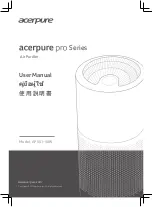
351579-YTS-B-0608
Johnson Controls Unitary Products
41
time 60 seconds (Non-adjustable). With this type of control, the
Power Exhaust fan cycle, as its operation directly influences the
building static pressure that controls it. The cycling rate is
limited by these minimum ON and OFF time settings. The
Building Pressure Setpoint default is 0.100" w.g.
ERV
During operation, the ERV [Energy Recovery Ventilation]
exhausts return air from the building, but it is not a 'power
exhaust'; the system is NOT controlled by building pressure. If
building pressure control is required, it must be done by other
means - standalone power exhaust, or power exhaust in
another unit serving the same space.
The ERV forces high volume fresh air exchange, but captures the
heat energy of the outgoing air and transfers it to the incoming
stream. ERV blower operation is NOT modulated to a pressure
setting; there is no building pressure transducer in the system. The
unit's supply fan pulls air through the inlet side of the ERV wheel.
Ducting and demand will vary from one installation to another.
Adjusting the unit to achieve fresh air requirements and
'exhaust-neutral' air flow must be done by the installer, using
the manual dampers in the unit.
If the unit is variable air volume, the ERV exhaust motors will be
controlled by a variable frequency drive in the Millennium
®
, using
the same signal voltage that modulates supply air, either by inlet
guide vane or variable frequency drive. This is done to keep
supply and exhaust air flow in balance.
The exhaust blowers in the ERV use the power and control
hardware that otherwise would run the power exhaust. The
EXH output from the
Simplicity
®
runs the ERV motors; if the
unit is VAV, the EXD+/- terminals provide the ERV variable
frequency drive speed signal.
Where a unit has both ERV and an economizer, the ERV will
stop wheel rotation when the economizer dampers open far
enough to trigger the user-settable switch in the damper
actuator. If free cooling is available, the heat exchange wheel
does not need to rotate; the wheel will cycle on schedule to
keep the air passages blown clean.
Also refer to the ERV Installation Instructions packaged with the
ERV.
SCHEDULING OPERATION
The Millennium
®
Simplicity
®
refers to its clock and internal
calendar.
COMPRESSOR STATUS MONITORING
Compressor status is monitored using two separate 24 VAC
circuits.
Monitoring: low pressure and high pressure.
The corresponding compressor status is monitored. If either of
the three safeties is in error, the trip is noted in the alarm history
and the next available compressor will be used if needed.
The Low Refrigerant Pressure Switch is Normally Open,
pressure closed. When the compressor is off and refrigerant
pressure equalized, the switch under normal conditions is
expected to be closed. However, in cold ambient operation, it
may stay open and close only after the compressor starts up.
If an error is detected for a compressor, that compressor’s
output is turned off (note that the controller executes the
application code once every 32ms, with a 30 second startup
delay and 5 second minimum error time on low pressure. The
control then declares a "Compressor Locked Out on [ ] Trip"
alarm. The alarm is written to the Error History Buffer.
NOTE:
The compressor lockout works as an override of the
output of the staging algorithm for cooling control. For
example, the cooling control may ask for compressor
#2 that is locked out, and as this request does not
generate additional cooling, will ask for the next com-
pressor, #3, to satisfy the cooling demand. If, after 10
minutes, the requested compressor #2 does start up,
the cooling output now may be exceeding demand,
and the control will turn off compressor #3, etc.




































